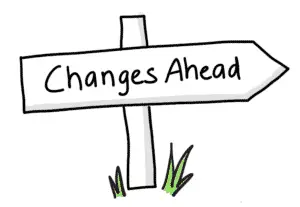Your website and your content must evolve with your business.
Why? Because, as we all know, the only constant in life is change!

Your services become more robust. Your team flourishes. The needs of your audience shift. As your business grows, you learn and grow as a leader, which provides you with more value to share with your audience.
And that’s where growth content comes in.
So, what is “growth content” anyways?
Well, first, we must define foundation content which is the core of your messaging and what we build on as you grow. Ultimately, it’s the “foundation” of your digital presence. This includes your website and other landing pages or sales pages.
Growth content refers to all additional pieces that work off of your messaging strategy and foundation. This includes social media copy, blogs, authority articles, and your portfolio.

What I love specifically about growth copy is that it is literally copy that helps you grow! You share it with your community, and your community shares it with other like-minded, potential clients. It helps you widen your reach, the possibilities of your organization, and connects you with new leads.
As you bring more clarity to your growth goals, consistent content is what helps you become an influencer in your niche, and build your authority as you educate your audience by sharing your knowledge. It allows you to dive deeper into SEO, optimize your copy to meet the search needs of your audience, and build content that supports your audience in their customer journey (ultimately leading them to taking action with you!).
The dangers of stagnant content
There are a few pieces of content on your website that MUST be consistently updated to keep you relevant with your audience (and to show that you are actively taking on new clients).
These big four pieces are your:
- Blog page
- Events page
- Product/service updates
- Portfolio
Now, you don’t necessarily need all of these things on your website (it really depends on where you are at in your business based), but I can assure you that a blog with only one post from 2015 is not going to do much for you or your audience.
Consistency and relevance to the changing needs of your audience MUST be addressed on your blog, otherwise, you might as well delete it. According to Orbit Media, the frequency of publishing and the length of posts plays the biggest role in marketing results (thanks to good ol’ SEO).

When it comes to events, product/services, and your portfolio, there is nothing worse than outdated dates (literally), images, pricing, and projects. Updating your website to keep content fresh is crucial for not only showing your audience how you support them, but to keep it professional (I dive into that in more detail here!). For example, no one is going to be looking at that course you offered four years ago that is still lingering on your event page. Honestly, it might make them wonder how serious you are about your business.
Remember: Most often than not, your website is your first impression with potential clients. Do you really want them to think you haven’t updated your site since 2010?
The difference between growth content and dynamic content
First, I just want to share the Oxford Dictionary definition for dynamic:
dynamic
adjective
- (of a process or system) characterized by constant change, activity, or progress.
“a dynamic economy” - (of a person) positive in attitude and full of energy and new ideas.
“a dynamic young advertising executive”
And dynamic content is exactly that: content that constantly changes based on your online user activities. In a nutshell, it’s recommended content, whether a blog post or a product, based on your browsing history, data, and behaviors on a particular website, all nicely presented to help you find what you’re looking for and take action.

For example, you know when you’re reading a blog post and at the bottom of the page an article of a similar topic is recommended to you? Or, when you’re shopping on an e-commerce site and after looking at a few products you might want to buy, it suddenly starts recommending products that you suddenly really want?
That’s the secret of dynamic copy – it’s crafting your unique online experience to best fit your needs and wants.
How does it work? Luckily, it’s an incredibly intelligent widget you can implement into your website that stores user information in a database. Using geotags and journey mapping, your website learns to automatically recommend similar content or products to website visitors that support them in taking action (click here to chat with me about how to implement this into your existing website).